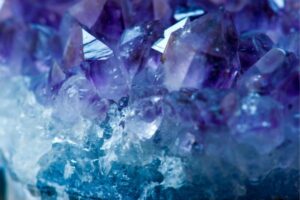Since the days of Aristotle and Plato right into our modern times, there are lots of theories about crystals and light. But, one thing is for sure, all through the ages and today, everyone absolutely loves crystals.
In fact, the first mention of the use of amulets and talismans goes back to the first days of humankind. Although we have no way of knowing how our ancestors put these items to use, they still hold a strong fascination for many.
Crystals and light have a remarkable relationship that has fascinated scientists and mystics for centuries. What makes crystals so special is their ability to bend and refract light, creating a mesmerizing display of colors and patterns. But the science of crystals and light goes beyond their aesthetic appeal. It’s a fascinating field of study that has led to numerous discoveries and innovations. From the use of crystals in lasers to the development of optical fibers, the applications of crystals and light are vast and varied.
Crystals and Light • The Fascinating Science Share on XIn this article, we’ll delve into the science behind crystals and light and explore how they work together to create such stunning visual displays. Whether you’re a science enthusiast or simply curious about the world around you, this topic is sure to captivate your imagination. So, let’s dive in and discover the wonders of crystals and light!
The structural science behind crystals and light
Crystals are a type of solid material that has a highly ordered internal structure. This structure is made up of repeating patterns of atoms, molecules, or ions, which are arranged in a three-dimensional lattice. The lattice structure of a crystal is what gives it its unique properties, such as its hardness, cleavage, and optical properties.
One of the most fascinating aspects of crystal structure is its ability to interact with light. When light enters a crystal, it interacts with the lattice structure and is refracted, or bent, in a specific way. This refraction creates a range of colors and patterns, depending on the crystal’s internal structure and the angle of the incident light.
The study of crystal structure is essential to many fields of science, including materials science, chemistry, and physics. Scientists use crystallography, a technique that involves X-ray diffraction, to determine the atomic structure of crystals. This information can be used to understand how crystals interact with light and other materials, and to develop new materials with unique properties.
The properties of light and how it interacts with crystals
Light is a form of electromagnetic radiation that travels in waves. It’s made up of particles called photons, which have energy and momentum. When light interacts with a crystal, it can be absorbed, reflected, or refracted, depending on the crystal’s internal structure and the angle of the incident light.
Refraction is the most common interaction between light and crystals. It occurs when light enters a crystal at an angle and is bent as it passes through the lattice structure. This bending of light is responsible for the beautiful colors and patterns that we see in crystals, such as the rainbow-like effect in a prism.
Different crystals have different refractive indexes, which determine how much the light is bent as it passes through the crystal. This property can be used to create lenses and other optical devices, such as microscopes and telescopes.
The study of light and its interactions with crystals is essential to many fields, including optics, photonics, and spectroscopy. Scientists use these techniques to develop new materials and devices that use light in innovative ways.
The history of crystal use for healing and spiritual practices
Crystals have been used for thousands of years in various spiritual and healing practices. Ancient civilizations believed that crystals had special powers and energies that could be used to heal the body and mind. Many cultures used crystals in rituals, ceremonies, and as talismans to protect against negative energies.
In modern times, crystal healing has become a popular alternative therapy. Practitioners believe that crystals can help balance the body’s energy fields, or chakras, and promote physical and emotional healing. Different crystals are associated with different healing properties, such as rose quartz for love and amethyst for clarity.
While there is little scientific evidence to support the effectiveness of crystal healing, many people find it to be a helpful and relaxing practice. The use of crystals in healing and spiritual practices continues to be a fascinating topic of study.
The benefits of incorporating crystals into your daily life
Incorporating crystals into your daily life can be a fun and rewarding way to connect with the natural world and promote well-being. Crystals can be used in a variety of ways, from wearing them as jewelry to placing them in your home or workplace.
One benefit of using crystals is their ability to promote a sense of calm and relaxation. Many people find that holding or meditating with crystals can help reduce stress and anxiety. Some crystals, such as citrine and pyrite, are also believed to promote abundance and prosperity.
Crystals can also be used to enhance creativity and focus. Clear quartz, for example, is said to help clarify the mind and enhance mental clarity. Amethyst is another crystal that is believed to promote creativity and inspiration.
Overall, incorporating crystals into your daily life can be a fun and meaningful way to connect with the natural world and promote well-being.
Types of crystals and their unique properties
There are thousands of different types of crystals, each with its unique properties and energies. Here are a few examples:
- Clear quartz: This crystal is known for its ability to amplify energy and promote mental clarity. It’s also said to be a powerful healing crystal.
- Rose quartz: This pink crystal is associated with love and compassion. It’s often used to promote emotional healing and self-love.
- Amethyst: This purple crystal is said to promote clarity and creativity. It’s also believed to help with addiction and insomnia.
- Citrine: This yellow crystal is often associated with abundance and prosperity. It’s also said to promote optimism and joy.
- Black tourmaline: This dark crystal is believed to protect against negative energies and promote grounding and stability.
These are just a few examples of the many types of crystals available. Each crystal has its unique properties and energies, and it’s important to choose the right crystal for your needs.
How to choose and care for your crystals
Choosing the right crystal can be a fun and enjoyable process. When selecting a crystal, it’s essential to trust your intuition and choose the crystal that resonates with you. You can also research the properties of different crystals and choose one that aligns with your needs and goals.
Caring for your crystals is also essential to maintain their energies and properties. Crystals should be cleansed regularly to remove any negative energies that may have accumulated. This can be done by placing them in sunlight or moonlight or by using other cleansing methods, such as smudging with sage or using a crystal singing bowl.
Storing your crystals in a safe and clean place is also essential. Some crystals are delicate and may be damaged by exposure to sunlight or moisture. It’s essential to keep them in a dry, cool place, away from direct sunlight.
Crystal healing practices and techniques
Crystal healing is a popular alternative therapy that uses crystals to promote physical and emotional healing. There are many different techniques and practices used in crystal healing, including:
- Placing crystals on specific parts of the body
- Creating crystal grids or layouts
- Holding or meditating with crystals
- Using crystal-infused oils or water
Each technique has its unique benefits and is used to promote different aspects of well-being. While there is little scientific evidence to support the effectiveness of crystal healing, many people find it to be a helpful and relaxing practice.
Research on the effectiveness of crystal healing
While crystal healing is a popular alternative therapy, there is little scientific evidence to support its effectiveness. However, some studies have shown that crystals may have a placebo effect, meaning that the belief in their healing properties may lead to a perceived improvement in symptoms.
One study published in the Journal of Complementary and Alternative Medicine found that crystal healing may be effective in reducing anxiety and stress in cancer patients. However, the study was small and lacked a control group, making it difficult to draw definitive conclusions.
Overall, while there is little scientific evidence to support the effectiveness of crystal healing, many people find it to be a helpful and relaxing practice.
Conclusion: The power of combining crystals and light for holistic well-being
In conclusion, the relationship between crystals and light is a fascinating topic that has captured the imagination of scientists and mystics for centuries. From the study of crystal structure to the use of crystals in healing and spiritual practices, this field of study has led to numerous innovations and discoveries.
Incorporating crystals into your daily life can be a fun and rewarding way to connect with the natural world and promote well-being. Whether you’re using them for their healing properties or simply admiring their beauty, the power of crystals and light is undeniable.
So, the next time you see a sparkling crystal or a mesmerizing light display, take a moment to appreciate the fascinating science behind it. The wonders of crystals and light are truly awe-inspiring.
Shopping Section
Several of these pieces are organic in nature. Explorers found beads made from mammoth ivory in a grave in Sungir, Russia. These beads date back to 60,000 years. The very first historical references of the use of crystals came from the Ancient Sumerian era. There, Ancient Sumerians used them in rituals.
Similarly, Ancient Egyptians used carnelian, clear quartz, lapis lazuli, emerald, and turquoise in their jewelry pieces. The ancient Greeks connected several properties with crystals. In fact, many still use that same knowledge from the Greek era in modern times.




a
In ancient China, jade was a highly valued crystal. Several ancient Chinese figures wore jade beads. Interestingly, around 1,000 years ago, musical instruments in China were also made from jade. Jade crystals are a greenish color in the light.



When white light hits a crystal
When a ray of white light hits a crystal, there occurs a beautiful phenomenon called ‘dispersion of light’. You might also see some rainbow-like occurrences in crystals which happens because of the dispersion of the white light.
Let’s explain this phenomenon in a simpler way! A crystal has several angles inside it. So when a ray of white light passes through it, it has to bend at different angles. That, in turn, causes the white light to split into its seven colors at various frequencies and various angles. The end result is a beautiful rainbow of different colors or simply VIBGYOR (Violet–Indigo–Blue–Green–Yellow–Orange–Red.). All of the colors that your eye detects are the “spectrum of colors“. When white light enters a crystal, the light separates into different wavelengths. The crystal’s internal facets further refract the wavelengths. The overall result is this rainbow spectral-like effect.
Crystals help us understand one fascinating fact about white light. White light is not actually white. White light contains within it all the colors of the rainbow. In fact, according to many scientists, white light contains millions upon millions of colors. The eye can see the VIBGYOR colors, but there are millions of other colors that your eye can not detect.
Reflection and refraction of crystals and light
Crystals are well-known for their sparkle and brilliance. Their brilliance is an optical property and is directly related to their BRI (Brilliance Refractive Index). BRI involves the bending of white light. When a crystal is hit by white light, the colors within the ray of light bend at different rates. This is because each wave of color in the VIBGYOR spectrum travels at a different speed. Red travels the fastest while, violet travels the slowest. Due to refraction, the colors bend and exit the crystal at a different angle and even faster speed.
A crystal’s BRI measurement is based on the refraction of light within a crystal. This is different from the reflection of light within a crystal. As I’ve stated, the refraction of light within a crystal is the bending of light. Meanwhile, the reflection of light is when light waves hit an object and do not bend. Instead, they reflect completely intact. You observe the reflection of light every time you look into a mirror. Light reflects back at you directly without bending. This is why you see an image of yourself in the same color as on the outside of the mirror.
Reflection and refraction can be observed in crystals because crystals are non-opaque objects. An opaque object is an object that does not allow waves of light to pass through it. An object can be opaque because it is too dense for light to pass through. When a ray of white light enters a non-opaque object such as a crystal, the light breaks down into different wavelengths. The crystal’s internal facets further refract the light. And that is when we finally see the overall result of a rainbow spectral-like effect.
How do crystals get their colors?
We adore crystals for their beautiful colors, but do you know that these colors are the result of impurities? Usually, the presence of certain minerals in crystals gives them a specific color. For example, the mesmerizing greenish hue of jade is due to chromium and iron impurities.
So, how do these impurities give crystals color when hit by light? The answer is, there are two different chemical structures that give crystals their color: Allochromatic chemical structure and Idiochromatic chemical structure.
The allochromatic chemical structure requires a combination of impurities to achieve its color. For instance, it takes titanium and iron to get blue Sapphire. Or, as I said before, chromium and iron impurities give jade its greenish. Emerald is produced by chromium and vanadium.
Idiochromatic chemical structure means that its chemical structure is made up of just one element. For example, the stone Peridot is made green by only one element. The same is true for emerald and ruby. They are colored by chromium.
There is one very important difference between Allochromatic and Idiochromatic chemical structures. In Allochromatic chemical structures, the impurities which add color are not critical to the structure of the gem. On the other hand, with an Idiochromatic chemical structure, the element is critical to the structure of the gym. This means if you were able to remove that element from the crystal, it would no longer be a crystal. It would be as ordinary, dull, and lifeless as a black, brown, or grey rock.
The Color of Emerald
Similarly, the color of emerald is due to the chromium ion replacing aluminum in certain locations of the structure. Chromium ion gives emerald crystals their beautiful dark-green glow in the light.

a
Sapphire’s Sky Blue
Sapphire’s sky-blue hue can be attributed to titanium and iron ions replacing aluminum ions in some locations.

a
Garnet’s Deep Red
Garnet’s color is due to iron 2+ ions replacing magnesium ions in some locations. Garnet crystal is more complex than other crystals. Most crystals can be identified using their chemical composition. However, Garnets are grouped into two separate “families”: Aluminum Garnets and Calcium garnets. The different chemical compositions within these families are the reason that you can find Garnets in different colors. Deep Red Garnet is in the family of Aluminum Garnets. Yet, they are rarely referred to as Aluminum Garnets. They are most often identified with a specific location such as the Mozambique garnet. Mozambique garnet has a deeper red than a normal garnet. Or they will be referred to as “Rhodolite” garnet crystals which have more of a pinkish hue in the light.

In similar ways, the colors of other crystals are either due to impurities or the diffraction of light passing through the crystal structure. Want to know more about these wonderful creations of Mother Nature? Then, I invite you to look below for other fascinating articles in this series.
Thank you for reading!
It is my hope that you find this post enlightening and helpful. If you have any questions or suggestions, we love to hear from you in the comments below. Also, kindly accept our invitation to join our group on Facebook to surround yourself with kindred spirits and post your encouraging messages.













































